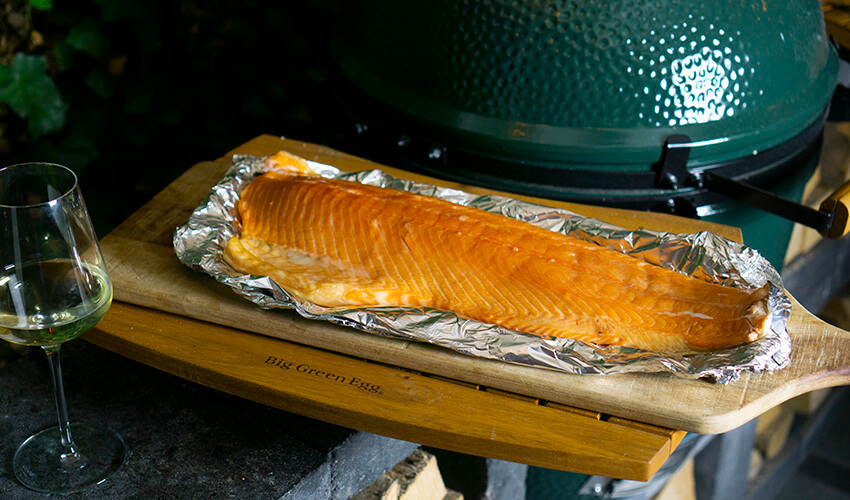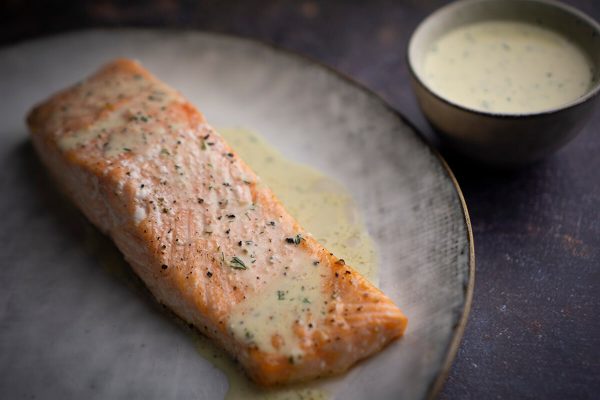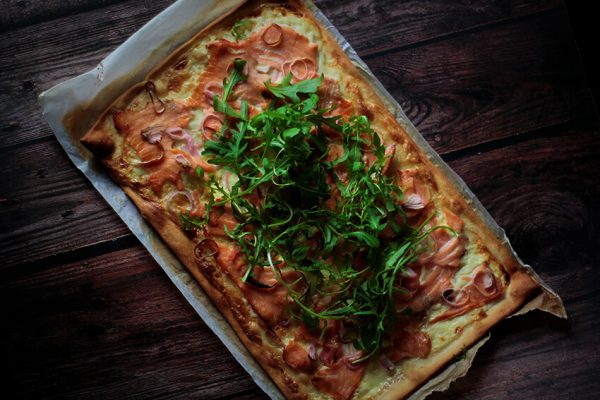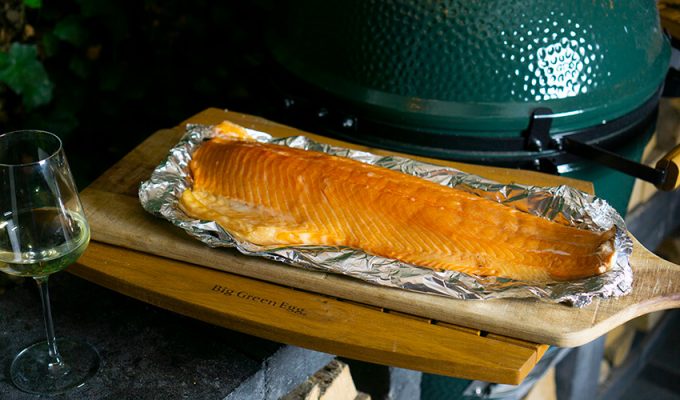Salmon: What kind of fish is it? And how do you prepare it?
From frying it, grilling it to cooking it in the oven
Salmon is a versatile fish and incredibly tasty. Even people who don’t like fish often like salmon. But what kind of fish is it exactly and what is the best way to cook it? Read all about it in this article.

Table of contents
- Chapter 1: What kind of fish is salmon?
- Chapter 2: Where does the fish come from?
- Chapter 3: How does salmon taste?
- Chapter 4: Is it healthy?
- Chapter 5: How to cook salmon?
- Chapter 6: Recipe: Grilled oriental spicy salmon
- Chapter 7: All recipes
Chapter 1
What kind of fish is salmon?
Salmon is loved worldwide for its unique taste and structure. There are 207 different salmon species. The most famous species is the Atlantic salmon. The meat of fresh Atlantic salmon is deep pink and has a firm structure.
The wild salmon is an anadromous fish. This means that the fish moves up the rivers from the sea to spawn. Salmon are born in freshwater rivers and as young salmon they migrate to the salt water of the sea.
When they are adults, they swim upstream back to the freshwater where they were born to lay eggs again. Most fish die after spawning.
Salmon is a carnivore by nature and lives in the sea on small marine animals such as shrimps and small fish. This fairly slender streamlined migratory fish is basically a white fish.
The shrimps that are eaten produce a red dye (astaxanthin). This red dye is stored in the fatty tissue of the salmon and gives the fish its characteristic light pink to deep red color.

Chapter 2
Where does the fish come from?
Atlantic salmon are native to rivers and seas in northern Europe and the Atlantic Ocean. In the wild, Atlantic salmon are not very common anymore.
Around 1965 they started breeding Atlantic salmon. Pacific salmon are found in the South Pacific and are usually caught wild.
Today salmon is farmed in Norway, Scotland, Ireland, the Faroe Islands, Iceland, North America, Chile and Tasmania. About 2 million tons of Atlantic salmon are farmed worldwide each year. This number is still increasing. Norway accounts for more than 60% of global salmon production, making it the most important country for salmon farming.
The farmed salmon is usually farmed in the sea, in floating round cages with a diameter of 30 to 60 meters and a depth of about 25 meters. To keep predators at a distance, a second cage is placed around the cage containing the salmon.
Pigment is added to the salmon feed, which is naturally present in the original feed (crayfish and shrimp). This salmon food gives the salmon its characteristic salmon pink color.
The most commercial salmons are:
- Chinook salmon or king salmon (Oncorhynchus tshawytscha)
- Sockeye salmon, also called “Sockeye” (Oncorhynchus nerka)
- Silver salmon or Coho salmon (Oncorhynchus kisutch)
- Pink salmon (Oncorhynchus gorbuscha)
- Keta salmon also called “Dog Salmon” (Oncorhynchus keta)
- Atlantic Salmon or Salmo Salar.
All of these types of salmon differ in taste and texture. The pink salmon is rated the least, while the Atlantic (wild) salmon is rated the highest in taste experience.
Chapter 3
How does salmon taste?
Salmon has a firm, meaty texture and doesn’t have a typical fishy flavor. It has a unique flavor that you can combine with almost any other flavor.
Salmon is special and the flavor is difficult to describe. The flavor and texture vary by type of salmon, breeding method, time of year and cooking method. But in general, salmon is a fatty fish and has a rich oily taste.
The fact that salmon tastes so delicious is mainly due to the high fat content of this fish. It’s a fatty fish and has a high content of unsaturated fatty acids.
It’s rich in the essential Omega-3 fatty acids (EPA and DHA) that are important for the health of the heart and blood vessels and the nervous system, among other things. In addition, salmon contains valuable proteins, vitamins and minerals.
The fish is available in salmon steaks, salmon fillets and salmon floss. You can also buy the fish in portions, planks, rolls, whole fish, burgers, chips, skewers, fish sticks, smoked salmon, tartare and other salmon specialties.

Chapter 4
Is it healthy?
In addition to being incredibly tasty, salmon is also healthy and very nutritious. Salmon is rich in omega-3 fatty acids. These are unsaturated fatty acids that protect us against cardiovascular disease. In addition, the B vitamins provide a higher energy level and brain activity.
Salmon is packed with healthy fats and valuable nutrients that are very good for your health. This type of fish can be cooked in countless ways and can be used very versatile for the tastiest recipes.
Hoofdstuk 5
How to cook salmon?
Depending on the cooking method, salmon gives an explosion of flavors in your mouth. Even people who don’t like fish often like salmon.
There are countless ways to make salmon dishes such as steaming, frying, stewing, poaching and smoking. You can also fry the salmon, cook it in the oven or grill it on the barbecue.
With a variety of spices that go well with salmon, you can make the dishes even more adventurous. For example, use allspice or fennel seeds for a Mediterranean touch. Saffron or ras el hanout provide an Arabic touch and ginger and/or lemongrass give an Asian flavor. You can also combine the marinade with lemon, white wine or gin.
Before you start cooking the salmon, it’s important to pat the pieces dry with kitchen paper. Then brush the fish with a little olive oil. The cooking time depends on the thickness of the salmon and the recipe. Always cook the salmon skin-side down. This way you protect the fish and it cooks more slowly without caramelizing.

Frying it in a pan
If you want to fry salmon, you do this at a high temperature.
- Heat the pan first.
- Place the salmon skin-side down in the pan and cook without moving it for about 4 to 5 minutes or until the skin separates from the pan.
- Turn the fish over and cook the other side for another minute or two.
- When the salmon is just cooked, it should be a little glassy inside.
- Place the salmon on a plate with the crispy skin side up.
- If necessary, season the fish with a little salt and pepper.

In the oven
If you want to cook the salmon slowly in the oven, do this at a low temperature.
- Preheat the oven to 150°C.
- Place the salmon skin-side down on a greased baking sheet.
- Season the fish with salt and pepper.
- Place the baking tray in the center of the oven.
- Bake the salmon rosé in about 15 to 20 minutes. The salmon is done when you press the thickest part of the steak and it almost falls apart.

Grilling on the barbecue
Barbecuing salmon gives the fish a delicious smoky flavor. If the coals are grey-white and there are no more flames and smoke to be seen, you can start grilling.
- Remove the salmon from the refrigerator beforehand.
- Season the salmon with some salt and pepper.
- Place the salmon skin-side down on the barbecue and grill the salmon on the least hot part for 3 to 4 minutes.
- Then carefully turn the salmon over. You can also use a fish clamp for grilling for convenience. The salmon is best when it’s grilled rosé. The fish meat is then soft and creamy.
Chapter 6
Recipe: Grilled oriental spicy salmon

Grilled oriental spicy salmon
Ingredients
- 1 cube chicken bouillon
- 250 ml water
- 70 ml soy sauce
- 40 grams brown sugar
- 1 tbsp sesame oil
- 1 tbsp sriracha chili
- 3 cloves garlic crushed
- 4 cm ginger grated
- 1.2 kg salmon descaled
Instructions
- Put the water with the chicken stock cube in a pan and bring it to the boil. When it boils you turn the heat down.
- Add the soy sauce, brown sugar, sesame oil, sriracha, garlic and ginger and heat to a slight boil. This way all the sugars dissolve and the marinade thicken a bit. Please note that this can take up to half an hour on low heat.
- Meanwhile, place the salmon skin side down on an aluminium foil. Pour some of the marinade on top of the salmon.
- Place the salmon on the barbecue with aluminium foil. Maintain a working temperature of about 250℃.
- Pour the marinade over the salmon every 2 minutes. The salmon is ready after about 12 minutes or at a core temperature of 45 ℃.
- Remove the salmon from the barbecue and pour the remaining marinade on top of the salmon.
Chapter 7
All recipes
Looking for more inspiration? Then see below more recipes with salmon. Or check our fish recipes for even more inspiration.
Oven baked salmon with dill sauce
Salmon might be one of the tastiest fish there is. It is rich in flavour, [...]
Jul
Flammkuchen with smoked salmon
Although it may seem like it, in Austria or Germany you don’t have to call [...]
Oct
Salmon with a herb crust
Salmon is a type of fish with which you can combine endlessly. The salmon lends [...]
May
Hot smoked salmon from the grill
Is smoking salmon difficult? It certainly is not! Besides the fact that we love a [...]
Oct
Grilled oriental spicy salmon
Several times we have served this salmon to visitors. Every time they tell us how [...]
Jan





